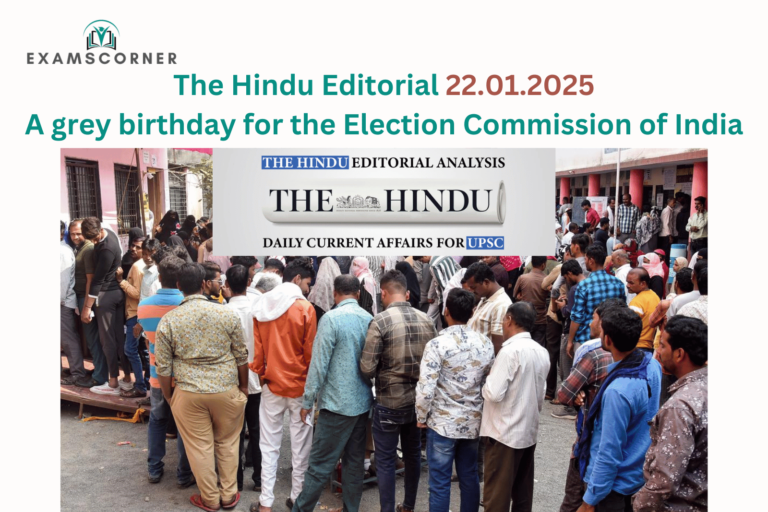Introduction
The sanctity of electoral rolls forms the cornerstone of India’s electoral democracy. On the 75th anniversary of its establishment (January 25), the Election Commission of India (ECI)—the body entrusted with ensuring free and fair elections—has little to celebrate. The vision laid down by India’s founding leaders, including Dr. B.R. Ambedkar, seems compromised. Dr. Ambedkar, while introducing the Constitutional provision for setting up the ECI in 1949, warned against electoral roll manipulation by the executive. His fears, unfortunately, appear to have materialized, as recent developments in Maharashtra reveal glaring discrepancies in voter enrollment.
The Case of Maharashtra: A Warning Sign
Unprecedented Voter Enrollment
For the 2024 Maharashtra State elections, the ECI enrolled 9.7 crore voters. In contrast, the Ministry of Health’s estimate pegged the adult population (18+ years) of Maharashtra at 9.54 crore. This means the ECI enrolled 16 lakh more voters than the estimated adult population—an anomaly that raises serious concerns.
While projections can vary, the enrollment of nearly 100% of the adult population for a single election is unusual. The ECI had not achieved such enrollment figures for previous elections, including the Lok Sabha election held just six months earlier.
Mass Enrollments in Record Time
Between the Lok Sabha and Maharashtra State elections, 48 lakh new voters were added to the rolls in just six months—a staggering figure, given that only 32 lakh voters were added over the previous five years (2019–2024). This sudden surge in voter registration is unprecedented.
Analyzing the BJP Alliance’s Vote Gain
The BJP-led Mahayuti alliance saw a significant gain of 72 lakh votes in the Maharashtra State election compared to the Lok Sabha election. A closer analysis reveals that only 24 lakh voters shifted allegiance from the Congress-led Maha Vikas Aghadi alliance to the BJP alliance. The remaining 48 lakh votes remain unaccounted for.
Unanswered Questions
- Where did the additional 48 lakh votes come from?
- How is it possible that all new voters seemingly voted for one alliance?
- Were these new voters genuine? Were their documents verified during enrollment?
The ECI officially confirmed enrolling the exact same number—48 lakh—of new voters during this period. Is this a miraculous coincidence, a case of divine intervention, or a worrying instance of executive interference, as Dr. Ambedkar forewarned?
Doubts About Electoral Roll Integrity
The sudden surge of voter registrations and their alignment with one political alliance raises troubling questions:
- Are these voters real, or are they ghost entries?
- Was due diligence conducted in verifying voter documents?
- Why did this phenomenon occur only for the Maharashtra State election?
Regardless of political affiliations, these discrepancies demand urgent investigation. The ECI must prioritize transparency and release all relevant data in the public domain to address these concerns.
The ECI’s Response and Defense
The Chief Election Commissioner has argued that if such large-scale voter manipulation occurred, opposition parties should have flagged it through their monitoring mechanisms. This argument shifts responsibility to political parties, attempting to absolve the ECI of accountability.
However, it is neither legal nor ethical to add dubious voters to influence an election outcome. The ECI’s constitutional mandate is to conduct free and fair elections, independent of political parties’ vigilance.
The Need for Aadhaar Integration in Electoral Rolls
The discrepancies in Maharashtra underscore the critical need to integrate Aadhaar into the electoral process. Aadhaar’s biometric verification can ‘unghost’ electoral rolls, ensuring de-duplication and preventing fraudulent entries.
Advantages of Aadhaar Integration
- Accuracy: Biometric verification can prevent ghost entries and duplication in electoral rolls.
- Accountability: Aadhaar can ensure that only legitimate voters are allowed to cast their votes.
- Backup Process: A robust backup mechanism can be implemented for cases where biometric verification fails to ensure no eligible voter is disenfranchised.
Implementing Aadhaar verification can strengthen the foundation of India’s electoral democracy and preserve its sanctity.
Conclusion: Restoring the Sanctity of Elections
As the ECI marks its 75th anniversary, it faces a critical juncture. The incident in Maharashtra highlights systemic vulnerabilities that threaten the integrity of India’s electoral democracy. Dr. Ambedkar’s words remind us that electoral rolls are the bedrock of a democracy, and their manipulation undermines the very essence of free and fair elections.
It is imperative for the ECI to act transparently, investigate discrepancies, and adopt modern tools like Aadhaar to ensure the accuracy of electoral rolls. As custodians of India’s democracy, the ECI must prioritize its constitutional duty to uphold the trust of the people. Strengthening electoral processes will not only honor the vision of India’s founding leaders but also safeguard the future of its democracy.
The sanctity of elections is not just a constitutional responsibility—it is the foundation of the nation’s democratic ideals.



